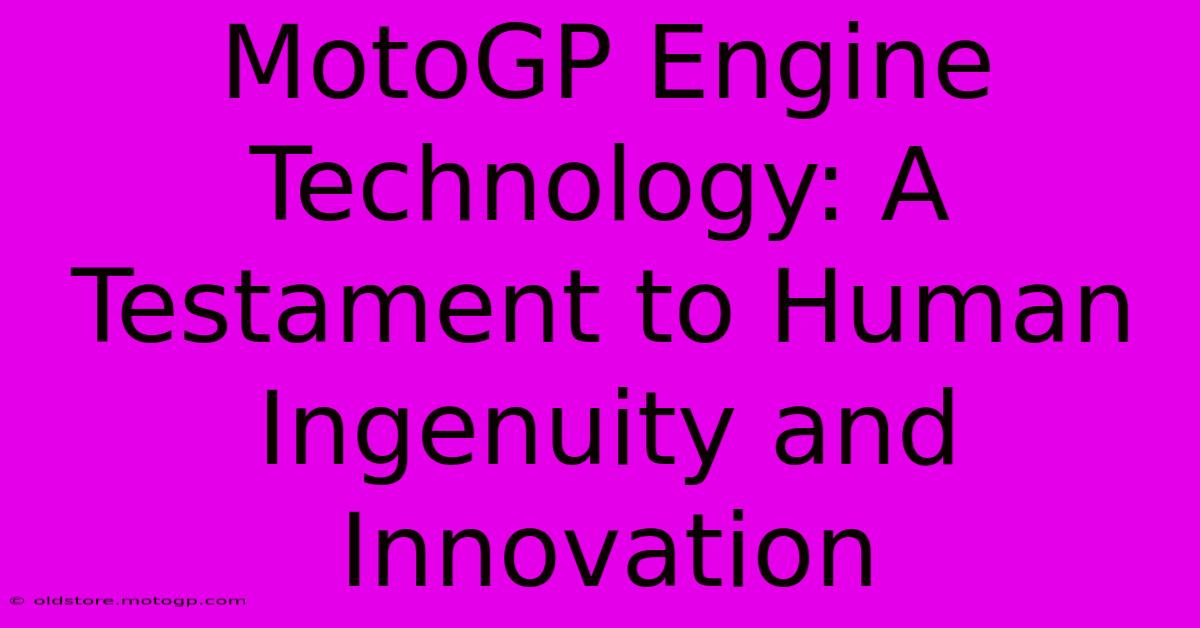MotoGP Engine Technology: A Testament To Human Ingenuity And Innovation

Table of Contents
MotoGP Engine Technology: A Testament to Human Ingenuity and Innovation
MotoGP, the pinnacle of motorcycle road racing, showcases not just incredible riding skill but also breathtaking technological advancements. The engines powering these machines are marvels of engineering, representing the cutting edge of internal combustion technology. This article delves into the sophisticated world of MotoGP engine technology, highlighting the ingenuity and constant innovation driving its evolution.
The Reign of the Four-Stroke: Power and Precision
Gone are the days of the screaming 500cc two-strokes. Since 2007, MotoGP has been dominated by four-stroke engines, primarily with a capacity of 1000cc. This shift brought about significant changes, demanding new approaches to power delivery, engine management, and overall design.
Key Features of Modern MotoGP Engines:
-
High Revving Capabilities: These engines are designed to operate at incredibly high RPMs, often exceeding 16,000 rpm, extracting maximum power from their relatively small displacement. This necessitates incredibly robust internal components.
-
Sophisticated Valve Train: Pneumatically actuated valves are commonly employed, allowing for faster valve actuation and precise control at these extreme engine speeds. This contributes to both power and efficiency.
-
Lightweight Materials: The quest for reduced weight is relentless. Titanium, magnesium, and carbon fiber are extensively used throughout the engine to minimize inertia and improve handling.
-
Advanced Fuel Injection: Precise electronic fuel injection systems optimize fuel delivery for optimal combustion, maximizing power output and minimizing emissions. These systems are finely tuned for specific track conditions and even varying points on the track.
-
Seamless Shifting: Seamless shift transmissions allow for faster gear changes without interrupting power delivery, a crucial advantage in close racing. This technology minimizes time lost during gear changes, offering a competitive edge.
-
Sophisticated Engine Management Systems: ECU (Engine Control Unit) technology plays a vital role, constantly monitoring and adjusting engine parameters like fuel injection, ignition timing, and valve actuation. These systems are highly complex and crucial for optimal performance.
Continuous Innovation: The Driving Force of MotoGP Engine Development
The MotoGP engine landscape is one of constant evolution. Teams are continually pushing the boundaries of what's possible, striving for even marginal gains in power, efficiency, and reliability.
Areas of Ongoing Development:
-
Aerodynamics: Engine design is intrinsically linked with aerodynamics. Innovative airbox designs and exhaust systems are crucial for optimizing airflow and maximizing power output.
-
Material Science: The ongoing search for lighter and stronger materials drives innovation, constantly seeking improvements in engine components. New alloys and composites are continuously being explored.
-
Electronics: Advancements in electronics, including ECU sophistication and sensor technology, provide an avenue for optimizing engine performance in real-time. Machine learning algorithms are even being explored for optimizing engine mapping.
The Human Element: Engineering Genius and Teamwork
The development of these incredibly complex engines is a testament to human ingenuity. It's not just about the technology; it's about the collaboration of highly skilled engineers, designers, and technicians working in concert. Their dedication, expertise, and relentless pursuit of perfection are what make MotoGP engine technology so extraordinary.
Conclusion: A Legacy of Progress
MotoGP engines represent the pinnacle of internal combustion engine technology. The continuous innovation and relentless pursuit of performance showcase the power of human ingenuity and the profound impact of collaborative effort. These engines are not merely components of racing machines; they are symbols of human achievement and a constant drive for advancement in engineering. The advancements seen in MotoGP frequently filter down to consumer motorcycles, indirectly benefiting riders worldwide. The future of MotoGP engine technology promises further exciting developments, pushing the limits of what's possible in the world of motorsports.

Thank you for visiting our website wich cover about MotoGP Engine Technology: A Testament To Human Ingenuity And Innovation. We hope the information provided has been useful to you. Feel free to contact us if you have any questions or need further assistance. See you next time and dont miss to bookmark.
Featured Posts
-
The Science Of Speed Understanding Moto Gp Aerodynamics
Feb 18, 2025
-
Cota Parking A Complete Visual Guide
Feb 18, 2025
-
The Shocking Price Tag Of A Moto Gp Beast
Feb 18, 2025
-
Austin F1 Map Discover The Best Places To Eat And Drink At Cota
Feb 18, 2025
-
Cota Track Days The Experience Of A Lifetime
Feb 18, 2025
